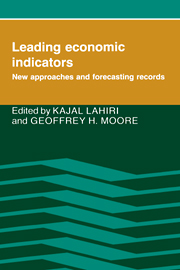Book contents
- Frontmatter
- Contents
- Preface
- List of contributors
- 1 Introduction
- PART I NEW CONCEPTS AND METHODS
- PART II FORECASTING RECORDS AND METHODS OF EVALUATION
- PART III NEW ECONOMIC INDICATORS
- 17 Commodity prices as a leading indicator of inflation
- 18 A leading indicator of inflation based on interest rates
- 19 Using composite leading indicators of consumption to forecast sales and to signal turning points in the stock market
- 20 Economic indicators for Australia's service sector
- 21 Purchasing management survey data: Their value as leading indicators
- 22 An agenda for inventories input to the leading composite index
- Index
22 - An agenda for inventories input to the leading composite index
Published online by Cambridge University Press: 05 June 2012
- Frontmatter
- Contents
- Preface
- List of contributors
- 1 Introduction
- PART I NEW CONCEPTS AND METHODS
- PART II FORECASTING RECORDS AND METHODS OF EVALUATION
- PART III NEW ECONOMIC INDICATORS
- 17 Commodity prices as a leading indicator of inflation
- 18 A leading indicator of inflation based on interest rates
- 19 Using composite leading indicators of consumption to forecast sales and to signal turning points in the stock market
- 20 Economic indicators for Australia's service sector
- 21 Purchasing management survey data: Their value as leading indicators
- 22 An agenda for inventories input to the leading composite index
- Index
Summary
A broadly based agreement exists among students of economic conditions that inventories play an important role in the periodic economic fluctuations from boom to bust and back again to boom. That finding by economists should not be praised as an extraordinary piece of brain work, however, because every manufacturer and trader, plus various functionaries, such as business managers and purchasing agents, and even sales clerks, can independently come to the same conclusion by observing the production, sales, and inventory records. In fact, the inventory data are collected with the help of those production and sales agents. The economists may have differences of opinion about how to best use and evaluate the inventory data so collected. This chapter, in effect, is concerned with the use of various inventory data for evaluation of current and future economic conditions.
Inventory data as a business cycle indicator
The application of inventory data may create misunderstanding when one does not carefully distinguish between flow and stock concepts relating to inventories. The flows and stocks have different timing sequences. To begin with, the flows are equivalent to changes and lead the cyclical timing in the stocks or aggregates (also referred to as levels). The accumulation of inventory stock has normally slowed down by the time the economic activity reaches a peak because the inventory flow (called inventory investment or buildup) has reached its peak some time prior to the cyclical peak and has been slowing down from that time point on.
- Type
- Chapter
- Information
- Leading Economic IndicatorsNew Approaches and Forecasting Records, pp. 429 - 460Publisher: Cambridge University PressPrint publication year: 1991



